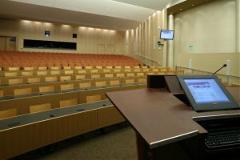Just as acoustics in a club or symphony hall can make or break a concert, meeting room acoustics can make or break an important conference call or video conference.

Alec Kasper-Olson, AVI Systems
When you hear the term acoustics, perhaps your favorite music venue or movie theater comes to mind. But acoustics are important in other spaces where you spend a lot of time as well — namely your company’s meeting rooms.
Just as acoustics in a club or symphony hall can make or break a concert, meeting room acoustics can make or break an important conference call or video conference. If your employees and clients can’t hear or understand each other, it can be difficult to get business done.
Acoustics are, simply put, the total effect of sound in a room. Your first instinct to improve meeting room acoustics might be to invest in more expensive audio visual equipment, but according to audio expert Pat Brown, that is not the right solution:
“The sound heard in an auditorium by a listener is a complex combination of the sound produced by the gear and the way that it interacts with the room. It’s a fact that most of the sound heard by any listener gets there only after many, many interactions with the room’s surfaces,” Brown was quoted saying in Shure’s blog. “Each reflection modifies the sound a bit, and after several interactions, it looks nothing like what left the loudspeaker in the first place. The room places its own signature on all sounds radiated into it, which can either enhance or corrupt the sound. Good gear doesn’t sound good when used in a bad room.”
If new equipment isn’t the solution to improve meeting room acoustics, what is? Let’s explore some simple changes you can make to improve meeting room acoustics and enhance the entire meeting experience for remote and in-person participants.
Identifying Acoustical Problem Areas
Speech is most easily understood in rooms with what is known as “dry” acoustics, in other words, rooms that reduce the reflection of sound off multiple surfaces that causes reverberation. But while good, dry meeting rooms acoustics are universally important, the causes of poor meeting room acoustics are various.
Is there a lot of distracting ambient or outside noise coming into your conference room from other parts of the office? Does your meeting room have a lot of flat, hard surfaces such as white boards, large screens or glass walls that create an uncomfortably high sound reverberation? The first step to improving meeting room acoustics is to identify what your problems or concerns are. Then you can invest in the right solution.
Sound Masking vs. Sound Absorption
To completely sound proof a meeting room and address both outside noise and distortion and reverberation inside the room, you’ll probably need a combination of sound masking and sound absorbing solutions.
Soundproofing products contain sound—such as hallway conversations—and prevent it from going other places—such as into your meeting room. Sound absorption products trap the noise bouncing around your conference room and prevent it from creating echoes and reverberations that make speech difficult to hear and understand. Here are some easy-to-implement sound masking and sound absorbing solutions to improve meeting room acoustics:
Sound Masking
- White noise. A soft background sound, like the kind created by a small water feature or a white noise machine, can cover the sound of outside noise and improve meeting room privacy.
- Soundproof drywall. Sound proof drywall is more expensive than regular drywall but it carries the extra benefit of increased mass density to block outside noise.
- Soundproof curtains. While acoustic curtains improve the sound quality in a room, soundproof curtains are made with heavy vinyl, known as mass-loaded vinyl or MLV, that block and contain sound. The stiff curtains hang from special frames making them easy to put up and take down.
Sound Absorption
- Acoustical ceiling tile. Acoustical ceiling tile is one of the most popular sound absorbing solutions. If your conference room has a drop ceiling and an open rather than ducted air return system, consider mineral board tiles instead.
- Hanging baffles. Acoustic hanging baffles are panels suspended perpendicular to the ceiling. Baffles are best for high ceilings or converted industrial space and can act as both a noise reduction and aesthetic solution as they come in a variety of colors, shapes, and sizes.
- Acoustic partitions. Partitions work like baffles but on the ground instead of the ceiling. They also have the benefit of being lightweight and easy to move around, so your acoustical solution can travel to wherever in the office you need it.
- Acoustic foam. While not as aesthetically pleasing as products such as baffles or partitions, acoustic foam does the same kind of job. Foam usually comes in square or wedge-shaped tiles of varying sizes and thicknesses. It is attached to ceilings or walls.
Start early to improve meeting room acoustics
Your meeting rooms are where ideas are born and deals are made and you’ve invested a lot of money into technology to facilitate that process.
Now it’s time to make sure your meeting room acoustics are helping you too. As with most improvements, the sooner you start the better. Putting the correct acoustical elements in place as you build your meeting spaces can help you hit the ground running with high sound quality for your in-person and virtual meetings.
But even retro-fitting your meeting rooms with acoustic-improving solutions can be an inexpensive way to improve the meeting experience and, ultimately, your bottom line.
This blog article was originally published here and is used with permission